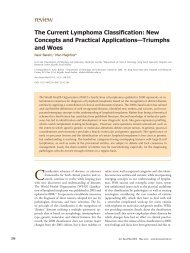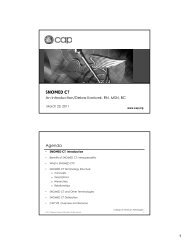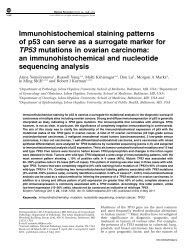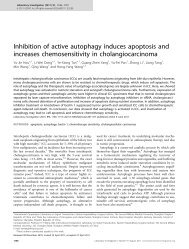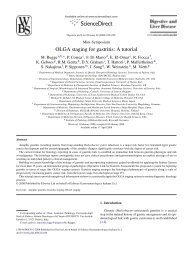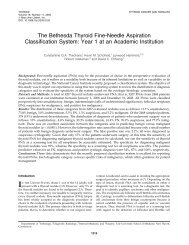Morphological subtypes of ovarian carcinoma: a ... - BPA Pathology
Morphological subtypes of ovarian carcinoma: a ... - BPA Pathology
Morphological subtypes of ovarian carcinoma: a ... - BPA Pathology
Create successful ePaper yourself
Turn your PDF publications into a flip-book with our unique Google optimized e-Paper software.
SUBTYPES OF OVARIAN CARCINOMA 4317. Seidman JD, Horkayne-Szakaly I, Haiba M, Boice CR, Kurman RJ,Ronnett BM. The histologic type and stage distribution <strong>of</strong> <strong>ovarian</strong><strong>carcinoma</strong>s <strong>of</strong> surface epithelial origin. Int J Gynecol Pathol 2004; 23:41–4.8. Köbel M, Kalloger SE, Huntsman DG, et al. Differences in tumor type inlow-stage versus high-stage <strong>ovarian</strong> <strong>carcinoma</strong>s. Int J Gynecol Pathol2010; 29: 203–11.9. Koonings PP, Campbell K, Mishell Dr, et al. Relative frequency <strong>of</strong>primary <strong>ovarian</strong> neoplasms: a ten year review. Obstet Gynecol 1989;74: 921–6.10. Bertelsen K, Holund B, Andersen E. Reproducibility and prognostic value<strong>of</strong> histologic type and grade in early epithelial <strong>ovarian</strong> cancer. Int JGynecol Cancer 1993; 3: 72–9.11. Baak JP, Langley FA, Talerman A, Delemarre JF. Interpathologist andintrapathologist disagreement in <strong>ovarian</strong> tumor grading and typing. AnalQuant Cytol Histol 1986; 8: 354–7.12. Cramer SF, Roth LM, Ulbright TM, et al. Evaluation <strong>of</strong> the reproducibility<strong>of</strong> the World Health Organization classification <strong>of</strong> common <strong>ovarian</strong>cancers. With emphasis on methodology. Arch Pathol Lab Med 1987;111: 819–29.13. Lund B, Thomsen HK, Olsen J. Reproducibility <strong>of</strong> histopathologicalevaluation in epithelial <strong>ovarian</strong> <strong>carcinoma</strong>. Clinical implications. APMIS1991; 99: 353–8.14. Sakamoto A, Sasaki H, Furusato M, et al. Observer disagreement inhistological classification <strong>of</strong> <strong>ovarian</strong> tumors in Japan. Gynecol Oncol1996; 54: 54–8.15. McCluggage WG, Lyness RW, Atkinson RJ, et al. <strong>Morphological</strong>effects <strong>of</strong> chemotherapy on <strong>ovarian</strong> <strong>carcinoma</strong>. J Clin Pathol 2002; 55:27–31.16. Miller K, Price JH, Dobbs SP, et al. An immunohistochemical andmorphological analysis <strong>of</strong> post-chemotherapy <strong>ovarian</strong> <strong>carcinoma</strong>. J ClinPathol 2008; 61: 652–7.17. Silverberg SG. Histopathologic grading <strong>of</strong> <strong>ovarian</strong> <strong>carcinoma</strong>: a reviewand proposal. Int J Gynecol Pathol 2000; 19: 7–15.18. Shimizu Y, Kamoi S, Amada S, et al. Toward the development <strong>of</strong> auniversal grading system for <strong>ovarian</strong> epithelial <strong>carcinoma</strong>. I. Prognosticsignificance <strong>of</strong> histopathologic features – problems involved in thearchitectural grading system. Gynecol Oncol 1998; 70: 2–12.19. Shimizu Y, Kamoi S, Amada S, et al. Toward the development <strong>of</strong> auniversal grading system for <strong>ovarian</strong> epithelial <strong>carcinoma</strong>: testing <strong>of</strong> aproponed system in a series <strong>of</strong> 461 patients with uniform treatment andfollow-up. Cancer 1998; 82: 893–901.20. Wilkinson N, McCluggage WG. Datasets for the HistopathologicalReporting <strong>of</strong> Neoplasms <strong>of</strong> the Ovaries and Fallopian Tubes and PrimaryCarcinomas <strong>of</strong> the Peritoneum. London: Royal College <strong>of</strong> Pathologists,July 2008.21. Russell HE, McCluggage WG. A multistep model for <strong>ovarian</strong> tumorigenesis:the value <strong>of</strong> mutation analysis in the KRAS and BRAF genes.J Pathol 2004; 203: 617–9.22. Singer G, Kurman RJ, Chang HW, et al. Diverse tumorigenic pathways in<strong>ovarian</strong> serous <strong>carcinoma</strong>. Am J Pathol 2002; 160: 1223–8.23. Singer G, Shih IM, Truskinovsky A, et al. Mutational analysis <strong>of</strong> K-rassegregates <strong>ovarian</strong> serous <strong>carcinoma</strong>s into two types: invasive MPSC(low-grade tumor) and conventional serous <strong>carcinoma</strong>. Int J GynecolPathol 2003; 22: 37–41.24. Singer G, Stohr R, Cope L, et al. Patterns <strong>of</strong> p53 mutations separate<strong>ovarian</strong> serous borderline tumors and low and high grade <strong>carcinoma</strong>s andprovide support for a new model <strong>of</strong> <strong>ovarian</strong> carcinogenesis: a mutationalanalysis with immunohistochemical correlation. Am J Surg Pathol 2005;29: 218–24.25. Ho C-L, Kurman RJ, Dehari R, et al. Mutations <strong>of</strong> BRAF and KRASprecede the development <strong>of</strong> <strong>ovarian</strong> serous borderline tumors. Can Res2004; 64: 6915–8.26. Sieben NLG, Macropoulos P, Roemen GMJM, et al. In <strong>ovarian</strong> neoplasms,BRAF, but not KRAS, mutation are restricted to low-grade seroustumours. J Pathol 2004; 202: 336–40.27. Vang R, Shih IeM, Kurman RJ. Ovarian low-grade and high-gradeserous <strong>carcinoma</strong>: pathogenesis, clinicopathologic and molecular biologicfeatures, and diagnostic problems. Adv Anat Pathol 2009; 16: 267–82.28. McCluggage WG. The pathology <strong>of</strong> and controversial aspects <strong>of</strong> <strong>ovarian</strong>borderline tumours. Curr Opin Oncol 2010; 22: 462–72.29. Seidman JD, Kurman RJ. Subclassification <strong>of</strong> serous borderline tumors <strong>of</strong>the ovary into benign and malignant types. A clinicopathologic study <strong>of</strong> 65advanced stage cases. Am J Surg Pathol 1996; 20: 1331–45.30. Kindelberger DW, Lee Y, Miron A, et al. Intraepithelial <strong>carcinoma</strong> <strong>of</strong> thefimbria and pelvic serous <strong>carcinoma</strong>: Evidence for a causal relationship.Am J Surg Pathol 2007; 31: 161–9.31. Lee Y, Medeiros F, Mindelberger D, et al. Advances in the recognition <strong>of</strong>tubal intraepithelial <strong>carcinoma</strong>: applications to cancer screening and thepathogenesis <strong>of</strong> <strong>ovarian</strong> cancer. Adv Anat Pathol 2006; 13: 1–7.32. Medeiros F, Muto MG, Lee Y, et al. The tubal fimbria is a preferred site forearly adeno<strong>carcinoma</strong> in women with familial <strong>ovarian</strong> cancer syndrome.Am J Surg Pathol 2007; 30: 230–6.33. Przybycin CG, Kurman RJ, Ronnett BM, et al. Are all pelvic (nonuterine)serous <strong>carcinoma</strong>s <strong>of</strong> tubal origin? Am J Surg Pathol 2010; 34: 1407–16.34. Lee Y, Miron A, Drapkin R, et al. A candidate precursor to serous<strong>carcinoma</strong> that originates in the distal fallopian tube. J Pathol 2007;211: 26–35.35. Herrington CS, McCluggage WG. The emerging role <strong>of</strong> the distalfallopian tube and p53 in pelvic serous carcinogenesis. J Pathol 2010;220: 5–6.36. Malpica A, Deavers MT, Lu K, et al. Grading <strong>ovarian</strong> serous <strong>carcinoma</strong>using a two-tier system. Am J Surg Pathol 2004; 28: 496–504.37. Malpica A, Deavers MT, Tornos C, et al. Interobserver and intraobservervariability <strong>of</strong> a two-tier system for grading <strong>ovarian</strong> serous <strong>carcinoma</strong>. Am JSurg Pathol 2007; 31: 1168–74.38. Dehari R, Kurman RJ, Logani S, et al. The development <strong>of</strong> high-gradeserous <strong>carcinoma</strong> from atypical proliferative (borderline) serous tumorsand low-grade micropapillary serous <strong>carcinoma</strong>: a morphologic andmolecular genetic analysis. Am J Surg Pathol 2007; 31: 1007–12.39. Silva EG, Deavers MT, Malpica A. Patterns <strong>of</strong> low-grade serous <strong>carcinoma</strong>with emphasis on the nonepitheliallined spaces pattern <strong>of</strong> invasionand the disorganised orphan papillae. Int J Gynecol Pathol 2010; 29: 507–12.40. O’Neill CJ, McBride HA, Connolly LE, et al. High-grade <strong>ovarian</strong> serous<strong>carcinoma</strong> exhibits significantly higher p16 expression than low-gradeserous <strong>carcinoma</strong> and serous borderline tumour. Histopathology 2007; 50:773–9.41. O’Neill CJ, Deavers MT, Malpica A, Foster H, McCluggage WG. Animmunohistochemical comparison between low-grade and high-grade<strong>ovarian</strong> serous <strong>carcinoma</strong>s. Significantly higher expression <strong>of</strong> p53,MIB1, bcl2, her-2/neu and C-KIT in high-grade neoplasms. Am J SurgPathol 2005; 29: 1034–41.42. Kobel M, Reuss A, Du Bois A, et al. The biological and clinical value <strong>of</strong>p53 expression in pelvic high-grade serous <strong>carcinoma</strong>s. J Pathol 2010;222: 191–8.43. Ahmed AA, Etemadmoghadam D, Temple J, et al. Driver mutations inTP53 are ubiquitous in high grade serous <strong>carcinoma</strong>s <strong>of</strong> the ovary. J Pathol2010; 221: 49–56.44. Gershenson DM, Sun CC, Lu KH, et al. Clinical behaviour <strong>of</strong> stage II-IVlow-grade serous <strong>carcinoma</strong> <strong>of</strong> the ovary. Obstet Gynecol 2006; 108: 361–8.45. Folkins A, Jarboe E, Saleemuddin A, et al. A candidate precursor to pelvicserous cancer (p53 signature) and its prevalence in ovaries and fallopiantubes from women with BRCA mutations. Gynecol Oncol 2008; 109:168–73.46. Hart WR. Mucinous tumors <strong>of</strong> the ovary: a review. Int J Gynecol Pathol2005; 24: 4–25.47. Lerwill MF, Young RH. Mucinous tumours <strong>of</strong> the ovary. Diagn Histopathol2008; 14: 366–87.48. Ronnett BM, Kajdacsy-Balla A, Gilks CB, et al. Mucinous borderline<strong>ovarian</strong> tumors: points <strong>of</strong> general agreement and persistent controversiesregarding nomenculature, diagnostic criteria, and behaviour. Hum Pathol2004; 35: 959–60.49. Lee KR, Young RH. The distinction between primary and secondarymucinous <strong>carcinoma</strong>s <strong>of</strong> the ovary: gross and histologic findings in50 cases. Am J Surg Pathol 2003; 27: 281–92.50. Seidman JD, Kurman RJ, Ronnett BM. Primary and metastatic mucinousadeno<strong>carcinoma</strong>s in the ovary: incidence in routine practice with a newapproach to improve intraoperative diagnosis. Am J Surg Pathol 2003; 27:985–93.51. Lewis MR, Deavers MT, Silva EG, Malpica A. Ovarian involvement bymetastatic colorectal adeno<strong>carcinoma</strong>: still a diagnostic challenge. Am JSurg Pathol 2006; 30: 177–84.52. McCluggage WG, Wilkinson N. Metastatic neoplasms involving theovary: a review with an emphasis on morphological and immunohistochemicalfeatures. Histopathology 2005; 47: 231–47.53. Berezowski K, Stasny JF, Kornstein MJ. Cytokeratins 7 and 20 andcarcinoembryonic antigen in <strong>ovarian</strong> and colonic <strong>carcinoma</strong>. Mod Pathol1996; 9: 1040–4.54. Lagendijk JH, Mullink H, van Diest PJ, Meijer GA, Meijer CJ. Immunohistochemicaldifferentiation between primary adeno<strong>carcinoma</strong>s <strong>of</strong> theovary and <strong>ovarian</strong> metastases <strong>of</strong> colon and breast origin. Comparisonbetween a statistical and intuitive approach. J Clin Pathol 1999; 52: 283–90.55. Park SO, Kim HS, Hong EK, et al. Expression <strong>of</strong> cytokeratins 7 and 20 inprimary <strong>carcinoma</strong>s <strong>of</strong> the stomach and colorectum and their value in thedifferential diagnosis <strong>of</strong> metastatic <strong>carcinoma</strong>s to the ovary. Hum Pathol2002; 33: 1078–85.56. Vang R, Gown AM, Wu LS, et al. Immunohistochemical expression <strong>of</strong>CDX2 in primary <strong>ovarian</strong> mucinous tumors and metastatic mucinousCopyright © Royal College <strong>of</strong> pathologists <strong>of</strong> Australasia. Unauthorized reproduction <strong>of</strong> this article is prohibited.




